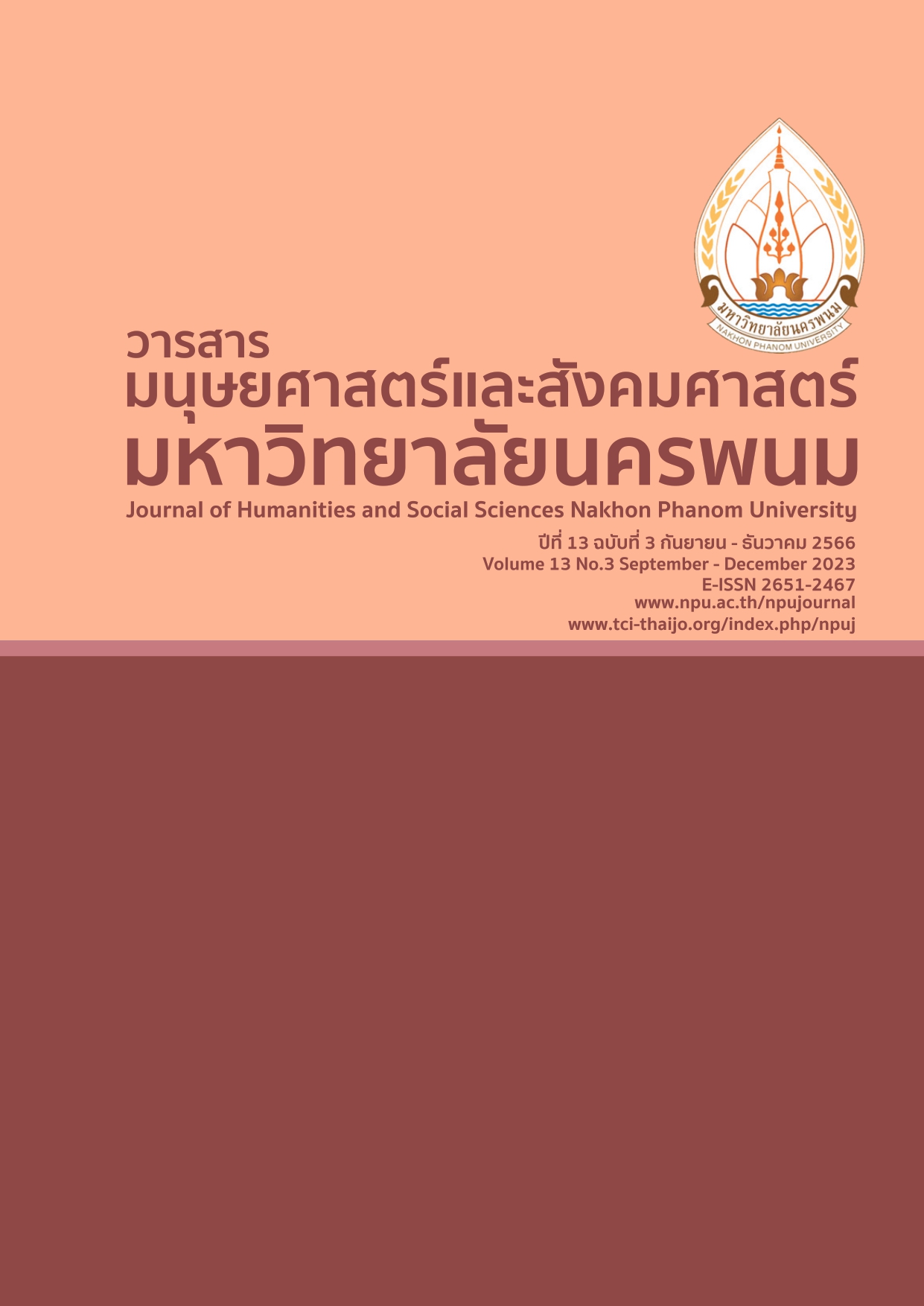กลไก และองค์ประกอบของเกมมิฟิเคชันที่ส่งผลต่อพลวัตของเกมมิฟิเคชัน: กรณีศึกษากลุ่มคนเจนเนอเรชั่น แซด ในประเทศไทย
Main Article Content
บทคัดย่อ
การวิจัยครั้งนี้มีวัตถุประสงค์เพื่อศึกษากลไก และองค์ประกอบของเกมมิฟิเคชันที่ส่งผลต่อพลวัตของเกมมิฟิเคชัน โดยเป็นการศึกษาเชิงปริมาณภาคตัดขวางของกลุ่มเจนเนอชั่น แซด จำนวน 350 คน ในประเทศไทย วิเคราะห์ข้อมูลโดยใช้สถิติ เชิงบรรยาย ได้แก่ ความถี่ ค่าเฉลี่ย และส่วนเบี่ยงเบนมาตรฐาน รวมทั้งการวิเคราะห์ความแปรปรวน ค่าสหสัมพันธ์ และการวิเคราะห์ถดถอย ตามลำดับ ผลการวิจัยพบว่า เพศ และระดับการศึกษาที่แตกต่างมีพลวัตของเกมมิฟิเคชันแตกต่างกันอย่างมีนัยสำคัญทางสถิติ .05 อย่างไรก็ตาม การวิเคราะห์ค่าสหสัมพันธ์ พบว่า การให้ผลตอบกลับ และความท้าทายของเกมมีค่าสหสัมพันธ์สูงสุด (r = .80, p < .00) รองลงมาได้แก่ ความท้าทาย และชนิดของเกม (r = .77, p < .00) นอกจากนี้ ผลการวิเคราะห์การถดถอยด้านกลไกของเกม พบว่า ค่าคะแนน ระดับ กระดานผู้นำ และทีม สามารถพยากรณ์พลวัตของ เกมมิฟิเคชัน องค์การสามารถนำผลการวิจัยไปประยุกต์ใช้ในการออกเป็นนโยบายในการพัฒนาทรัพยากรมนุษย์ในองค์การ โดยใช้กระบวนการเกมมิฟิเคชัน ซึ่งจะสามารถทำให้องค์การเพิ่มขีดความสามารถในการแข่งขันได้ต่อไป
Article Details

อนุญาตภายใต้เงื่อนไข Creative Commons Attribution-NonCommercial-NoDerivatives 4.0 International License.
เอกสารอ้างอิง
Brune, A. (2021). Gen Z Gamers: Key Insights. Retrieved March 2023, from https://newzoo.com/insights/articles/ gen-z-gamers-key-insights.
Cochran, W. G. (1953). Sampling techniques. New York : John Wiley & Sons.
Denton, M. (2022). Game mechanics & game dynamics: Gamification 101. Retrieved March 2023 from https://www.gamify.com/gamification-blog/gamification-101-game-mechanics-game-dynamics
Goethe, O. (2019). Visual aesthetics in games and gamification. In Gamification Mindset (pp. 85-92). Springer, Cham.
Grünewald, H., Kneip, P. and Kozica, A. (2019). The use of gamification in workplace learning to encourage employee motivation and engagement. The Wiley handbook of global workplace learning. 1,557-575. https://doi.org/10.1002/9781119227793.ch29
Kaufman, D. A. (2018). Reflection: Benefits of gamification in online higher education. Journal of Instructional Research. 7,125-132. https://eric.ed.gov/?id=EJ1188367
Krishnamurthy, K., Selvaraj, N. and Gupta, P. (2022). Benefits of gamification in medical education. Clinical Anatomy. 35(6),795-807. https://doi.org/10.1002/ca.23916
Landers, R. N., Bauer, K. N. and Callan, R. C. (2017). Gamification of task performance with leaderboards: A goal setting experiment. Computers in Human Behavior. 71,508-515. https://doi.org/10.1016/j.chb.2015.08.008
Lithoxoidou, et al. (2020). A novel social gamified collaboration platform enriched with shop-floor data and feedback for the improvement of the productivity, safety and engagement in factories. Computers & Industrial Engineering. 139,105691. https://doi.org/10.1016/j.cie.2019.02.005.
Liu, M., Huang, Y. and Zhang, D. (2018). Gamification’s impact on manufacturing: Enhancing job motivation, satisfaction and operational performance with smartphone-based gamified job design. Human Factors and Ergonomics in Manufacturing & Service Industries. 28(1),38–51. https://doi.org/10.1002/hfm.20723.
McGonigal, J. (2011). Reality is broken: Why games make us better and how they can change the world. USA : Penguin.
Moore-Russo, D., Wiss, A. and Grabowski, J. (2017). Integration of gamification into course design: A noble endeavor with potential pitfalls. College Teaching. 1-13. doi:10.1080/87567555.2017.1295016
Nivedhitha, K. S. and Manzoor, A. S. (2020). Gamification inducing creative ideation: A parallel mediation model. Behaviour & Information Technology. 39(9),970-994. https://doi.org/10.1080/0144929X.2019. 1635646
Rakrong, P., Banjongrod, T. and Utitasarn, C. (2022). The Effects of Mathematics learning through gamification approach online practice worksheet on Mathematics achievement of Mathayomsuksa 1 Students. Journal of Education Studies. 50(2),1-14. https://doi.org/10.14456/educu.2022.17
Sailer, M. and Homner, L. (2020). The gamification of learning: A meta-analysis. Educational Psychology Review. 32(1),77-112. https://doi.org/10.1007/s10648-019-09498-w
Satomuhammas, S. (2018). The development of learning activity using gamification technique to rise Mathematics learning achievement about linear equation system for Mattayom 3 students, Suankularb Wittayalai Thinburi School. Bangkok, Research Report. Office of the Basic Education Commission. Ministry of Education, Thailand.
Saxena, M. and Mishra, D. K. (2021). Gamification and Gen Z in higher education: A systematic review of literature. International Journal of Information and Communication Technology Education (IJICTE). 17(4),1-22.
Seemiller, C. and Grace, M. (2016). Generation Z goes to college. USA : John Wiley & Sons.
Suwannaslip, T. (2021). Gamification. Bangkok : Salt.
Thomas, N. J., Baral, R. and Crocco, O. S. (2022). Gamification for HRD: Systematic Review and Future Research Directions. Human Resource Development Review, 21(2). 198-224. https://doi.org/10.1177/15344843221074859
Vesa, M., Hamari, J., Harviainen, J. T. and Warmelink, H. (2017). Computer games and organization studies. Organization Studies. 38(2),273–284. https://doi.org/10.1177/ 0170840616663242
Vanichbuncha. K. (2007). Statistical analysis: Statistics for management and research. (10th ed). Bangkok : Chulalongkorn University Press.
Wuttaphan, N. (2018, November). Diversity Management: When Generation Z Comes to the Workplace and How Human Resources Can Manage. In Proceedings of the 7th Business, Economics and Communications International Conference, Phitsanulok, Thailand (pp. 29-30). Phitsanulok, Naresuan University.


